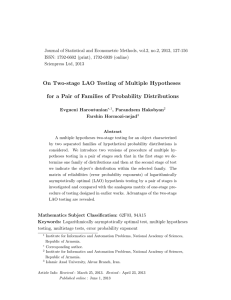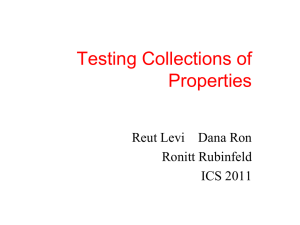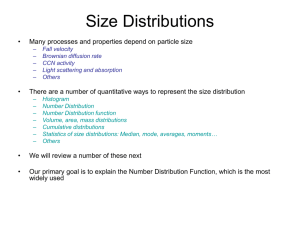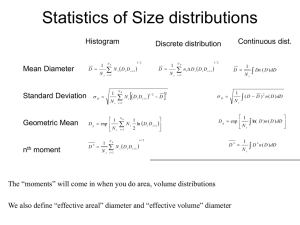Document 10812941
advertisement
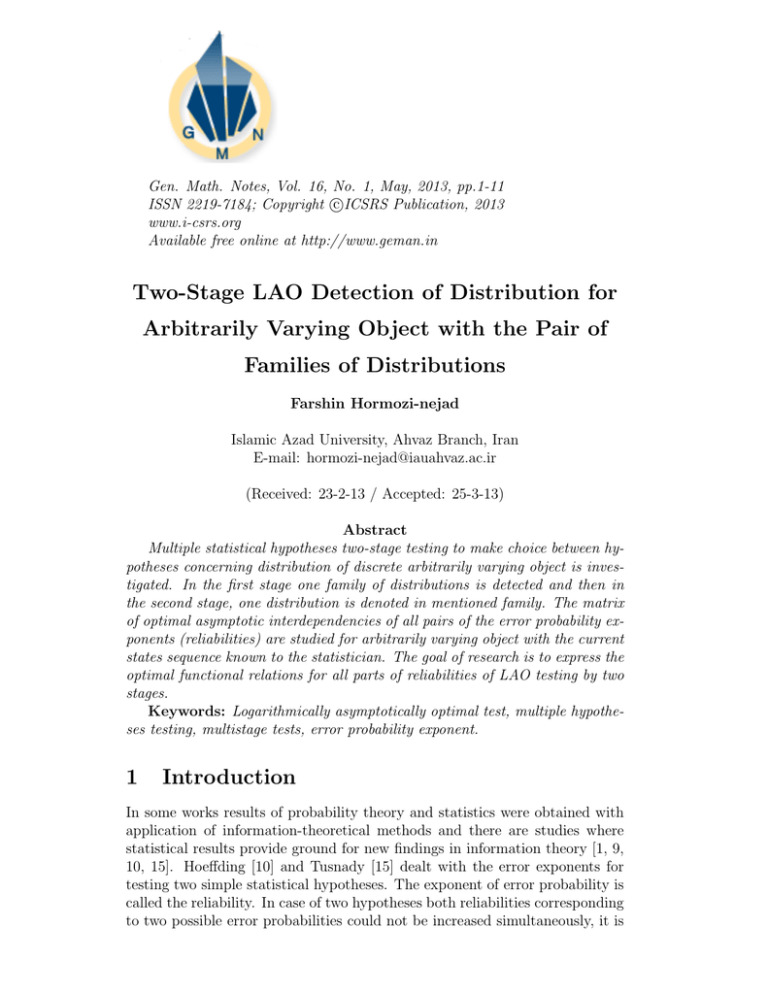
Gen. Math. Notes, Vol. 16, No. 1, May, 2013, pp.1-11
c
ISSN 2219-7184; Copyright ICSRS
Publication, 2013
www.i-csrs.org
Available free online at http://www.geman.in
Two-Stage LAO Detection of Distribution for
Arbitrarily Varying Object with the Pair of
Families of Distributions
Farshin Hormozi-nejad
Islamic Azad University, Ahvaz Branch, Iran
E-mail: hormozi-nejad@iauahvaz.ac.ir
(Received: 23-2-13 / Accepted: 25-3-13)
Abstract
Multiple statistical hypotheses two-stage testing to make choice between hypotheses concerning distribution of discrete arbitrarily varying object is investigated. In the first stage one family of distributions is detected and then in
the second stage, one distribution is denoted in mentioned family. The matrix
of optimal asymptotic interdependencies of all pairs of the error probability exponents (reliabilities) are studied for arbitrarily varying object with the current
states sequence known to the statistician. The goal of research is to express the
optimal functional relations for all parts of reliabilities of LAO testing by two
stages.
Keywords: Logarithmically asymptotically optimal test, multiple hypotheses testing, multistage tests, error probability exponent.
1
Introduction
In some works results of probability theory and statistics were obtained with
application of information-theoretical methods and there are studies where
statistical results provide ground for new findings in information theory [1, 9,
10, 15]. Hoeffding [10] and Tusnady [15] dealt with the error exponents for
testing two simple statistical hypotheses. The exponent of error probability is
called the reliability. In case of two hypotheses both reliabilities corresponding
to two possible error probabilities could not be increased simultaneously, it is
2
Farshin Hormozi-nejad
an accepted way to fix the value of one of the reliabilities and try to make the
tests sequence get the greatest value of the remaining reliability. Such a test
is called logarithmically asymptotically optimal (LAO). The need of testing of
more than two hypotheses in many scientific and applied fields has essentially
increased recently. Ahlswede et al. [1] and Haroutunian [6] formulated some
problems of multiple hypotheses testing and identification. Haroutunian et al.
[9] investigated the problem of LAO testing of multiple statistical hypotheses.
Fu and Shen [5] and Haroutunian et al. [8] declared hypothesis testing for
arbitrarily varying source. The model of the two-stage LAO testing in multiple
hypotheses for a pair of families of distributions is investigated in [7, 12].
In some researches the problem of detection are investigated such as works
of Chen and Papamarcou [2], Shalaby and Papamarcou [13], Tsitsiklis and
Athans [14] and Willett and Warren [16]. The two-stage multiple hypotheses
LAO test of distributed detection system for many families of distributions
is investigated in [11]. This paper is dedicated to the two-stage detection of
distribution concerning distributions of arbitrarily varying object.
2
Preliminaries
Random variable (RV) X characterizing the studied object takes values in the
discrete finite set X and P(X ) is the space of all distributions on X . Suppose
G be the alphabet of states of the object. The state g ∈ G of the object changes
independently each moment of time n. S possible conditional probability distributions (PD) of X are given. Suppose P(g) be a set of conditional PDs
as
P(g) = {P1 (x|g), P2 (x|g), ..., PS (x|g)}, x ∈ X , g ∈ G.
consists of S PDs of X which are divided to two disjoint families of PDs. The
first family
P1 (g) = {P1 (x|g), P2 (x|g), ..., PR (x|g)}, x ∈ X , g ∈ G,
includes R hypotheses and the second family
P2 (g) = {PR+1 (x|g), PR+2 (x|g), ..., PS (x|g)}, x ∈ X , g ∈ G,
consists of S − R hypotheses. It is not known which of these alternative
hypotheses Hs : P (x|g) = Ps (x|g), s = 1, S, is in reality and it must be
detected.
Let N -sample x = (x1 , x2 , . . . , xN ), be a vector of results of N independent
observations of the RV X. The source of states of the object produces vector
g = (g1 , g2 , ..., gN ), gn ∈ G, n = 1, N .
3
Two-Stage LAO Detection of Distribution for...
The purpose of the procedure is using sample x dependent on g for detecting
the actual PD from given family of PDs. The probability of vector x for given
states vector g is
N
Y
PsN (x|g) =
Ps (xn |gn ), s = 1, S.
n=1
Let us introduce two sets of indices D1 = {1, R} and D2 = {R + 1, S} and a
pair of disjoint families of PDs
P1 (g) = {Ps (x|g), s ∈ D1 },
P2 (g) = {Ps (x|g), s ∈ D2 }.
The entropy of RV X with PD Q and the divergence (Kullback-Leibler distance) of PDs Q and P , are defined [3, 4] as follows:
4
HQ (X) = −
X
Q(x) log Q(x),
x∈X
4
D (Q k P ) =
X
x∈X
Q(x) log
Q(x)
.
P (x)
The method of types is a base of our proofs, so here some definitions and
estimates are reminded [3, 4, 9]. Let N (g|g) be the number of repetitions of
the element g ∈ G in the vector g ∈ G N , and
4
πg (g) = N (g|g)/N , g ∈ G,
is the PD, called in information theory the type of vector g. For a pair of
vectors x ∈ X N and g ∈ G N , let N (x, g|x, g) be the number of occurrences of
pair (x, g) ∈ X × G in the pair of vectors (x, g). The joint type of the pair of
vectors (x, g) is defined by
4
Qx,g (x, g) = N (x, g|x, g)/N , x ∈ X , g ∈ G.
The conditional type of x for given g is the conditional distribution defined by
Qx|g (x|g) =
Qx,g (x, g)
N (x, g|x, g)
=
, x ∈ X , g ∈ G.
πg (g)
N (g|g)
Let X and G be RVs defined by probability distributions Q(x|g) and π(g).
The conditional entropy of X respective to G is:
4
Hπ,Q (X|G) = −
X
x∈X ,g∈G
π(g)Q(x|g) log Q(x|g).
4
Farshin Hormozi-nejad
The conditional divergence of the distribution π◦Q = {π(g)Q(x|g), x ∈ X , g ∈
G} with respect to the distribution π ◦ Ps = {π(g)Ps (x|g), x ∈ X , g ∈ G} is
4
4
D (π ◦ Q k π ◦ Ps ) = D (Q k Ps |π) =
X
π(g)Q(x|g) log
x∈X ,g∈G
Q(x|g)
.
Ps (x|g)
Let P N (X ) be the set of all possible types on X N for N observations, TQN be
the set of all vectors x of the type Q ∈ P N (X ), P N (G) be the set of all types
on G for given N , P(G) be the set of all possible probability distributions π on
G and QN (X|g) be the set of all possible conditional types on X for given g.
Also suppose that TπNg ,Qx|g (X|g) be the family of vectors x of the conditional
type Q for given g of the type πg . The following well known properties of
types will be used [3, 9]:
|QN (X|g)| ≤ (N + 1)|X ||G| ,
(N + 1)−|X ||G| . exp N Hπg ,Qx|g (X|G) ≤ |TπNg ,Qx|g (X|g)| ≤ exp N Hπg ,Qx|g (X|G) ,
for x ∈ TπNg ,Qx|g (X|g) :
PsN (x|g) = exp − N (Hπ,Q (X|G) + D(Q k Ps |π) .
3
The Two-Stage LAO Detection
Suppose N = N1 + N2 be such that:
N1 = dψN e, N2 = [(1 − ψ)N ], 0 < ψ < 1,
x = (x1 , x2 ), x ∈ X N , X N = X N1 × X N2 ,
g = (g1 , g2 ), g ∈ G N , G N = G N1 × G N2 .
The two-stage procedure on the base of N -sample is denoted by ΦN . Such
N2
1
test may be realized by a pair of tests ϕN
1 and ϕ2 for two consecutive stages
N2
1
and it is written by ΦN = (ϕN
1 , ϕ2 ). The first stage is a non-randomized
N1
test ϕ1 (x1 , g1 ) based on the joint sample (x1 , g1 ). The next stage is a nonN1
2
randomized test ϕN
2 (x2 , g2 , ϕ1 ) based on joint sample (x2 , g2 ) and the out1
come of test ϕN
1 (x1 , g1 ).
3.1
First Stage of Two-stage Test
The first stage of decision making for detection of a family of PDs denoted by
N1
1
a test ϕN
on two
1 (x1 , g1 ), can be defined by division of the sample space X
distinct subsets
4
N1
1
AN
i (x1 |g1 ) = {x1 : ϕ1 (x1 , g1 ) = i}, i = 1, 2.
5
Two-Stage LAO Detection of Distribution for...
Source of data
Source of states
g=(g1, g2)
P1 , P2 , …, PS
(x1, g1)
First Detector
{1, 2}
(x2, g2)
Final Detector
(Pl )
Figure 1: The two-stage detection with arbitrarily varying object
1
The set AN
i , i = 1, 2, consists all vectors x1 for which i-th family of PDs is
adopted.
0
1
Let αi|j
(ϕN
1 ), i 6= j, i, j = 1, 2, be the probability of the erroneous acceptance of the i-th family of PDs provided that the j-th family of PDs is true
(that is the correct PD is in the j-th family):
4
N1
0
N1
1
αi|j
(ϕN
1 ) = max max Ps (Ai ), i 6= j, i, j = 1, 2.
g1 ∈G N1 s∈Dj
The reliabilities of the infinite sequence of tests ϕ1 are defined by
1
4
N1
0
0
log αi|j (ϕ1 ) , i, j = 1, 2.
Ei|j (ϕ1 ) = lim inf −
N1 →∞
N1
(1)
(2)
The matrix of reliabilities for the first stage of the test is E0 (ϕ1 ) and one can
see from (1)-(2) that
0
0
Ej|j
= Ei|j
, i, j = 1, 2, i 6= j.
For construction of the necessary LAO test ϕ∗1 for preliminarily given positive
0∗
value E1|1
, the following subsets of distributions are defined:
1
A∗N
1 (x1 |g1 ) =
[
TπNg 1,Qx
1
0∗
Qx1 |g1 : min D(Qx1 |g1 ||Ps |πg1 )≤E1|1
s∈D1
1 |g1
(X|g1 ),
N1
1
1
and A∗N
\ A∗N
2 (x1 |g1 ) = X
1 (x1 |g1 ).
0
∗
Theorem 3.1. If the positive value E1|1
, is such that the following inequality
hold
0∗
E1|1
< min D(Pl ||Ps ),
(3)
l∈D2 , s∈D1
6
Farshin Hormozi-nejad
then there exists a LAO sequence of procedures ϕ∗1 such that other reliability
0∗
E2|2
is positive and is defined by
0
∗
= min min
E2|2
inf
π∈P(G) s∈D2 Q: min D(Q||Pl |π)≤E 0 ∗
1|1
D(Q||Ps |π).
l∈D1
Proof. By applying the properties of types and using the definition of the
reliability, error probability is estimated as follows:
∗N 0
1
N1
1
)
=
max
P
α1|1 (ϕ∗N
max
A1
1
s
g1 ∈G N1 s∈D1
= max max PsN1
[
TπNg 1,Qx
1
g1 ∈G N1 s∈D1
0
1 |g1
∗
Qx1 |g1 : min D(Qx1 |g1 ||Ps |πg1 )>E1|1
s∈D1
≤ max max(N1 + 1)|X ||G|
g1 ∈G N1 s∈D1
sup
0
∗
Qx1 |g1 : min D(Qx1 |g1 ||Ps |πg1 )>E1|1
PsN1 TπNg 1,Qx
1
1 |g1
s∈D1
≤ max max(N1 +1)|X ||G|
g1 ∈G N1 s∈D1
sup
0
exp −N1 D(Qx1 |g1 ||Ps |πg1 )
∗
Qx1 |g1 : min D(Qx1 |g1 ||Ps |πg1 )>E1|1
s∈D1
n
= exp −N1
min
min
o
D(Qx1 |g1 ||Ps |πg1 )−oN1 (1)
inf
πg1 ∈P N1 (G) s∈D1 Qx |g : min D(Qx |g ||Ps |πg1 )>E 0 ∗
1|1
1 1
1 1
s∈D1
n
o
0∗
≤ exp −N1 {E1|1
− oN1 (1)} .
0
where oN1 (1) → 0 is received by N1 → ∞. From here it follows that E1|1 (ϕ∗1 ) =
0∗
.
E1|1
The another error probability is estimated as follows:
0
∗N1
N1
1
α2|2 (ϕ∗N
)
=
max
max
P
A
1
1
s
g1 ∈G N1 s∈D2
= max max PsN1
g1 ∈G N1 s∈D2
[
TπNg 1,Qx
1
0
1 |g1
∗
Qx1 |g1 : min D(Qx1 |g1 ||Ps |πg1 )≤E1|1
s∈D1
≤ max max (N1 + 1)|X ||G|
g1 ∈G N1 s∈D2
sup
0
∗
Qx1 |g1 : min D(Qx1 |g1 ||Ps |πg1 )≤E1|1
PsN1 TπNg 1,Qx
1
1 |g1
s∈D1
≤ max max(N1 +1)|X ||G|
g1 ∈G N1 s∈D2
sup
0
exp −N1 D(Qx1 |g1 ||Ps |πg1 )
∗
Qx1 |g1 : min D(Qx1 |g1 ||Ps |πg1 )≤E1|1
s∈D2
= exp
n
− N1
min
min
inf
πg1 ∈P N1 (G) s∈D2 Qx |g : min D(Qx |g ||Ps |πg1 )≤E 0 ∗
1|1
1 1
1 1
s∈D1
D(Qx1 |g1 ||Ps |πg1 )
Two-Stage LAO Detection of Distribution for...
7
o
−oN1 (1) .
(4)
Now let us prove the inverse inequality
0
N1
1
1
A∗N
α2|2 (ϕ∗N
1
1 ) = max max Ps
g1 ∈G N1 s∈D2
= max
g1 ∈G N1
max PsN1
s∈D2
[
0
TπNg 1,Qx |g
1
1 1
∗
Qx1 |g1 : min D(Qx1 |g1 ||Ps |πg1 )≤E1|1
s∈D1
≥ max max
sup
0∗
g1 ∈G N1 s∈D2 Q
x1 |g1 : min D(Qx1 |g1 ||Ps |πg1 )≤E1|1
PsN1
TπNg 1,Qx |g
1
1 1
s∈D1
≥ max max
sup
0∗
g1 ∈G N1 s∈D2 Q
x1 |g1 : min D(Qx1 |g1 ||Ps |πg1 )≤E1|1
exp −N1 D(Qx1 |g1 ||Ps |πg1 )
s∈D2
= exp
n
− N1
min
min
inf
πg1 ∈P N1 (G) s∈D2 Qx |g : min D(Qx |g ||Ps |πg1 )≤E 0 ∗
1|1
1 1
1 1
D(Qx1 |g1 ||Ps |πg1 )
s∈D1
o
+oN1 (1) .
(5)
According to the definition of the reliability (2), equations (4) and (5) will
gain:
0∗
E2|2
= min min
inf
D(Q||Ps |π).
0
π∈P(G) s∈D2 Q: min D(Q||Pl |π)≤E ∗
1|1
l∈D1
3.2
Second Stage of the Two-Stage Test
N1
N2
2
The test ϕN
2 (x2 , g2 , ϕ1 ) can be defined by division of the sample space X
to R (or S − R) distinct subsets. If the i-th family of PDs is accepted, then
4
N2
N1
1
BsN2 (x2 |g2 , ϕN
1 = i) = {x2 : ϕ2 (x2 , g2 , ϕ1 ) = s}, s ∈ Di , i = 1, 2.
The probability of the fallacious acceptance at the second stage of test of PD
Pl , when Ps is correct, is
4
N2
00
N2
2
αl|s
(ϕN
2 ) = Ps (Bl ), l 6= s, l, s = 1, S.
The probability to reject Ps , when it is true and the first family of PDs is
accepted, is
4
N2
00
N2
2
αs|s
(ϕN
2 ) = Ps (B s ) =
X
l6=s
00
2
αl|s
(ϕN
2 ), l, s = 1, S.
(6)
8
Farshin Hormozi-nejad
Corresponding reliabilities for the second stage of test, are
4
00
El|s
(ϕ2 ) =
1
N2
00
lim inf −
log αl|s (ϕ2 ) , l, s = 1, S.
N2 →∞
N2
(7)
It follows from (6) and (7)
00
00
Es|s
(ϕ2 ) = min El|s
(ϕ2 ), l, s = 1, S.
l6=s
Theorem 3.2. [6, 7] If at the first stage of test the first family of PDs
00
, s = 1, R − 1 of the matrix of
is accepted, then for given positive values Es|s
00
reliabilities E (ϕ2 ) let us consider the regions:
R00s (π)
=
0∗
Q : minD(Q||Pl |π) ≤ E1|1 , D (Q k Ps |π) ≤
l∈D1
n
0∗
,
R00R (π) = Q : minD(Q||Pl |π) ≤ E1|1
l∈D1
00
Es|s
, s = 1, R − 1,
o
00
D (Q k Ps |π) > Es|s
, s = 1, R − 1 ,
and the following values of elements of the future matrix of reliabilities E00 (ϕ∗2 )
of the LAO test sequence:
00∗
00
= Es|s
, s = 1, R − 1,
Es|s
00∗
El|s
= min
inf D (Q k Ps |π) , l = 1, R, s = 1, S, l 6= s.
π∈P(G) Q∈R00
l
If the following compatibility conditions are valid
00
E1|1
< min D(Ps k P1 ),
s=2,R
00∗
00
Es|s
< min[ min El|s
, min D(Pl k Ps )],
l=1,s−1
2 ≤ s ≤ R − 1,
l=s+1,R
00∗
of matrix of reliathen there exists a LAO sequence of tests ϕ∗2 , elements El|s
00
∗
bilities E (ϕ2 ) of which are defined above and are positive.
If one compatibility condition is violated, then at least one element of the matrix E00 (ϕ∗2 ) is equal to zero.
When the second family of PDs is accepted, then Theorem 3.2 with replacing s = R + 1, S will be used.
9
Two-Stage LAO Detection of Distribution for...
3.3
Reliabilities of Two-Stage Test
In the two-stage decision making, the test Φ∗N can be defined by partition of
the sample space X N to S separate subsets as follows
4
1
× BsN2 , s ∈ Di , i = 1, 2.
CsN = A∗N
i
000
000
Definitions of error probabilities αl|s
(Φ∗N ) and reliabilities El|s
(Φ∗2 ) can be used
similar to Section 3. So error probabilities are considered as follows
a) if l, s ∈ Di , i = 1, 2 then
000
1
) · PsN2 (BlN2 )
αl|s
(Φ∗N ) = PsN1 (A∗N
i
(8)
b) if s ∈ Di and l ∈ Dj , i, j = 1, 2, i 6= j then
000
1
αl|s
(Φ∗N ) = PsN1 (A∗N
) · PsN2 (BlN2 )
j
(9)
By using properties of types the following equalities are created:
1
4
N
∗N
I
lim − log Ps (Aj ) = min inf ∗ D(Q||Ps |π) = Ej|s
, s∈
/ Dj . (10)
N →∞
π∈P(G) Q:Q∈Aj
N
According to equations (8)–(10) and definition of reliabilities are obtained:
a) if l, s ∈ Di , i = 1, 2 then
000
00∗
El|s
(Φ∗ ) = (1 − ψ)El|s
,
(11)
b) if s ∈ Di and l ∈ Dj , i, j = 1, 2, i 6= j then
000
I
00∗
El|s
(Φ∗ ) = ψEj|s
+ (1 − ψ)El|s
,
(12)
c) if s ∈ Di , i = 1, 2 then
000
000
Es|s
(Φ∗ ) = min El|s
(Φ∗2 ),
l6=s
(13)
Theorem 3.3. If all compatibility conditions of Theorems 3.1 and 3.2 are
satisfied, then elements of matrix of reliabilities E000 (Φ∗ ) of the two-stage detection Φ∗ are defined in equations (11)–(13).
When one of compatibility condition is violated, then at least one element of
E000 (Φ∗ ) is equal to zero.
4
Discussion and Conclusion
Detection of distribution for multiple hypotheses two-stage test concerning
distributions from arbitrarily varying object is considered and the optimal
functional relations between the reliabilities of two-stage detection are investigated. It can be shown that the number of operations of the two-stage test
is less than this of one-stage detection. It is shown for one invariant object in
[7, 12]. Also the problem with arbitrarily varying object can be examined for
hypotheses detection concerning two or more arbitrarily varying objects and
at for many families of PDs.
10
Farshin Hormozi-nejad
References
[1] R. Ahlswede and E.A. Haroutunian, On statistical hypotheses optimal
testing and identification, Lecture Notes in Computer Science, General
Theory of Information Transfer and Combinatorics, Springer, 4123(2006),
462-478.
[2] P. Chen and A. Papamarcou, New asymptotic results in parallel distributed detection, IEEE Transactions on Information Theory, 39(6)
(1993), 1847-1863.
[3] T.M. Cover and J.A. Tomas, Elements of Information Theory (Second
Edition), Wiley, NewYork, (2006).
[4] I. Csiszar and P. Shields, Information theory and statistics: A tutorial,
Foundations and Trends in Communications and Information Theory,
1(4) (2004), 417-528.
[5] F.W. Fu and S.Y. Shen, Hypothesis testing for arbitrarily varying source
with exponential-type constraint, IEEE Transactions on Information
Theory, 44(2) (1998), 892-895.
[6] E.A. Haroutunian, Logarithmically asymptotically optimal testing of multiple statistical hypotheses, Problems of Control and Information Theory,
19(1990), 413-421.
[7] E.A. Haroutunian, P.M. Hakobyan and F. Hormozi-nejad, On two-stage
logarithmically asymptotically optimal testing of multiple hypotheses concerning distributions from the pair of families, Transactions of IIAP of
NAS of RA, Mathematical Problems of Computer Science, 37(2012), 3442.
[8] E.A. Haroutunian, P.M. Hakobyan and A.O. Yessayan, Many hypotheses LAO testing with rejection of decision for arbitrarily varying object,
Transactions of IIAP of NAS of RA, Mathematical Problems of Computer
Science, 35(2011), 77-85.
[9] E.A. Haroutunian, M.E. Haroutunian and A.N. Haroutunyan, Reliability
criteria in information theory and in statistical hypothesis testing, Foundations and Trends in Communications and Information Theory, 4(2-3)
(2008), 97-263.
[10] W. Hoeffding, Asymptotically optimal tests for multinomial distributions,
Annals of Mathematical Statistics, 36(1965), 369-401.
Two-Stage LAO Detection of Distribution for...
11
[11] F. Hormozi-nejad, Two-stage multiple hypotheses LAO test of distributed
detection system for many families of distributions, Journal of Applied
Sciences, 13(2) (2013), 201-206.
[12] F. Hormozi-nejad, E.A. Haroutunian and P.M. Hakobyan, On LAO testing of multiple hypotheses for the pair of families of distributions, Proceeding of the Conference Computer Science and Information Technologies,
Yerevan, Armenia, (2011), 135-138.
[13] H. Shalaby and A. Papamarcou, Multiterminal detection with zerorate data compression, IEEE Transactions on Information Theory, 38(2)
(1992), 254-267.
[14] J. Tsitsiklis and M. Athans, On the complexity of decentralized decision
making and detection problems, IEEE Transactions on Information Theory, AC-30(5) (1985), 440-446.
[15] G. Tusnady, On asymptotically optimal tests, Annals of Statistics, 5(2)
(1977), 385-393.
[16] P. Willett and D. Warren, The suboptimality of randomized tests in distributed and quantized detection systems, IEEE Transactions on Information Theory, 38(2) (1992), 355-361.
